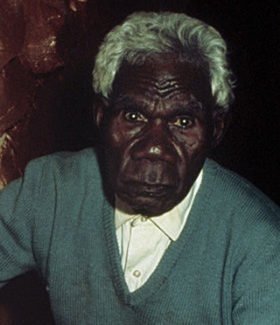CHARLIE NUMBULMOORE
MARKET ANALYSIS

Charlie Numbulmoore’s works are rare and have a primitive numinous appeal. His paintings have appeared at auction only 35 times and, in what is extremely rare in Aboriginal art sales, only six have been passed in with all but two of his ten highest results exceeding their high estimates.
Amongst those works offered more than once was a 62 x 38.5 cm bark, which just exceeded its top estimate of $30,000 at Sotheby’s in 2000 and four years later sold for $49,850, showing an increase of $14,200. Two Spotted Wandjina c.1965 has appeared three times. This 78 x 60 cm work executed in earth pigments on cardboard achieved a price of $23,500 against a presale estimate of $18,000-25,000 when it first appeared for sale in Deutscher~Menzies in May 2000 (Lot 30). Three years later, it reappeared at Lawson Menzies October 2003 sale with a slightly higher estimate of $25,000-35,000 and reached $35,250 (Lot 33). In a result that reflects Sotheby’s preference for ethnographic works, this painting sold for $72,000 when re-offered in July 2007 against a presale estimate of $40,000-50,000 (Lot 30). Only a work on slate, sold by Sotheby's in 2002 for $22,800, cost its owner when resold in 2012 through Bonham's for $18,300. Still, the pleasure derived from living with it should have more than compensated. In 2018 a bark that originally failed to sell through Leonard Joel in September 2015 when estimated at $12,000 – $18,000, was pushed by Sotheby's in London at GBP25,000 – 35,000 and failed once more. His highest price is $228,000, paid for an unusually large work measuring 161 x 80 cm at Sotheby’s in July 2007 (Lot 28). During 2006-07 no less than four works exceeded his previous record of $71,000 paid for a painted coolamon in Sotheby’s July 2005 auction.
Since 2000 Numbulmorre has fetched high sums, often outstripping the estimates set by auction houses by up to three times. Moreover, there is a high degree of acceptance of the eclectic array of surfaces on which his images are painted, with works on cardboard, slate, plywood, bark, and painted coollamons all fetching high prices. These staggering prices paid for works that only recently would have been considered artefacts or ethnographic curiosities attest to a fascination engendered by the Wandjina image itself. In Numbulmoore’s case, the use of his image on the cover of Images of Power, Aboriginal Art from The Kimberley, published by the National Gallery of Victoria, has only added to his status as one of the most important exponents of this art.
Though Charlie Numbulmoore’s barks predate Alec Mingelmanganu’s canvases by up to a decade, Numbulmoore’s results rank just behind Mingelmanganu on the secondary market before the low numbers offered are taken into account. Works by both of these artists are now firmly established as blue-chip investments and will become increasingly difficult to obtain. The $228,000 record price paid for Numbulmoore’s Wandjina image in Sotheby’s 2007 sale just eclipsed his record of the previous year. These results were more than three times his record set only a year earlier and just barely below the record sale of a Wandjina bark by Alec Mingelmanganu at Sotheby’s in June 2002. That only four have failed at auction is a testament to both the scarcity and desirability of Numbulmoore’s work. Such a result at auction is practically unheard of and all the more unusual because of the high value of his lowest sales record at $15,600. It is indicative that in 2015 only one work appeared for sale. It was offered in Sotheby's sale of the Thomas Vroom collection in London. The bark was far from his best and badly damaged, yet it achieved one of Numbulmoore's highest results, selling for GBP equivalent of $AUD34,920.
With works of such uniformly superb quality, there is little risk of depreciation. Numbulmoore’s works are rare, with only ten being offered for sale since 2007; they will always be strongly contested when they appear at sale. While they may seem rich pickings, I believe that his paintings are still undervalued, and collectors should expect to see them continue to surge in value.
© Adrian Newstead

